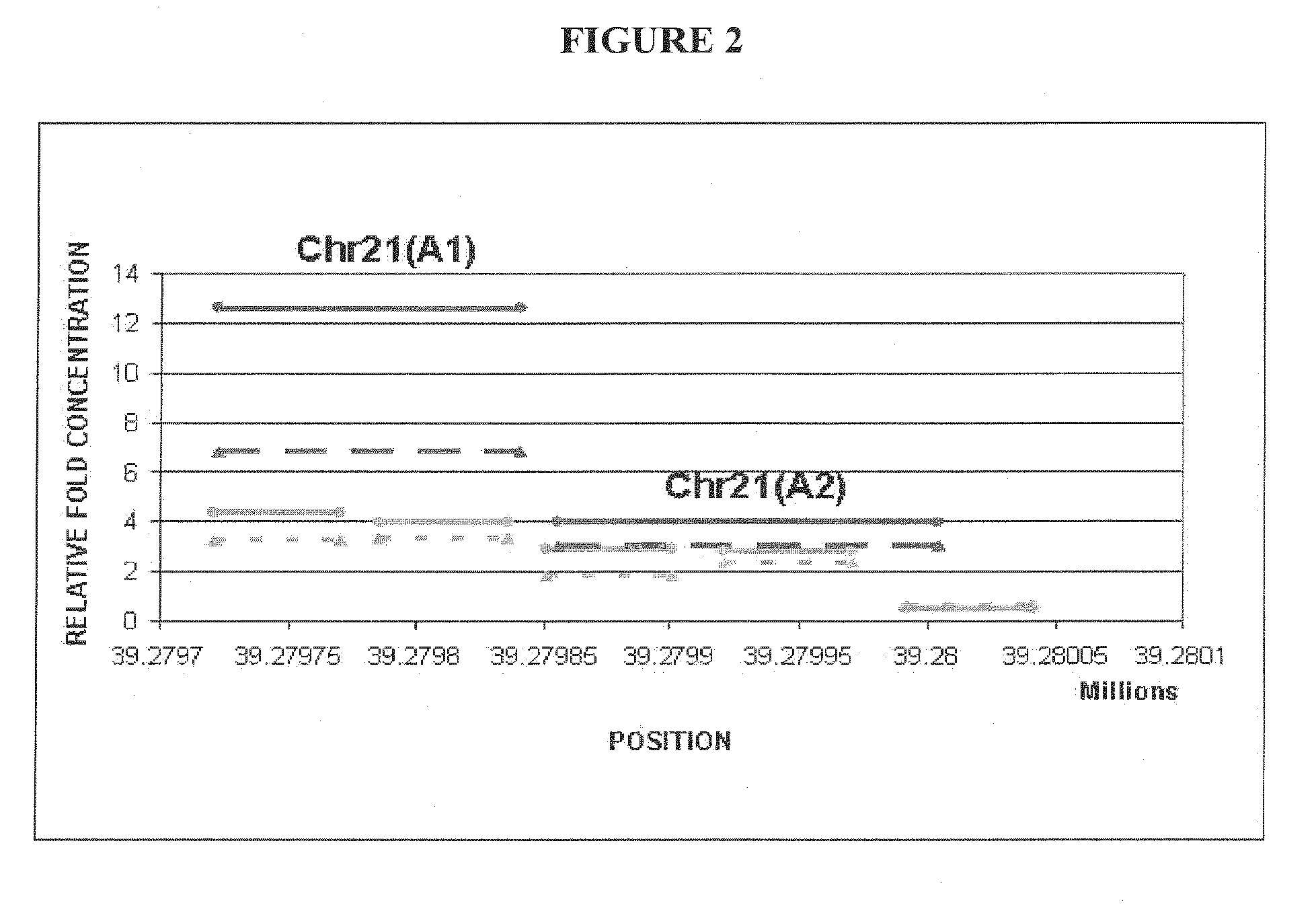Methods and compositions for noninvasive prenatal diagnosis of fetal aneuploidies
a non-invasive, prenatal diagnosis technology, applied in the direction of microorganism testing/measurement, sugar derivatives, biochemistry apparatus and processes, etc., can solve the problems of limited number of genomic regions identified or tested to date, significant risk of fetal loss, and current methods developed using ffdna for non-invasive prenatal diagnosis subject to a number of limitations, so as to accurately predict trisomy 21 diagnosis of fetal aneuploidies
- Summary
- Abstract
- Description
- Claims
- Application Information
AI Technical Summary
Benefits of technology
Problems solved by technology
Method used
Image
Examples
example 1
Identification of Sites of Differential DNA Methylation Between Placental and Peripheral Blood
[0126]In this example, differentially methylated regions (DMRs) were identified for chromosomes 13, 18, 21, X and Y, using a system coupling MeDiP with high resolution tiling oligonucleotide array analysis to enable chromosome-wide identification of DNA methylation patterns in a high-throughput approach.
[0127]The experiments described in this example are also described in Papageorgiou, E. A. et al. (2009) Am. J. Pathol. 174:1609-1618, the entire contents of which, including all supplemental data and materials, is explicitly incorporated herein by reference.
Materials and Methods
[0128]Human Samples
[0129]The samples used in this study were obtained from AMS Biotechnology (Europe) Ltd (Oxon, UK). These samples, originally sourced from the Biochain Institute (Hayward, Calif.), were subject to consent using ethical Internal Review Board (IRB) approved protocols.
[0130]In total, five female normal ...
example 2
Additional Description of Identification of Differentially Methylated Regions (DMRs)
[0158]This example provides an additional description of how differentially methylated regions (DMRs) were identified and, from those DMRs, the ones which are hypomethylated in maternal DNA and hypermethylated in fetal DNA were preferentially chosen. A flowchart diagram of the methodology is shown in FIG. 5. The diagram shows the application of the MeDiP LM-PCR methodology and the oligo-array hybridization procedure towards the identification of DMRs across chromosomes 13, 18, 21, X and Y.
Samples
[0159]The DNA samples from one normal adult female peripheral blood (PB), one normal first trimester placenta (PL1) and one normal third trimester placenta (PL3) were obtained from unrelated individuals and were supplied from AMS Biotechnology (Europe) Ltd (Oxon, UK) which were originally sourced from the Biochain Institute (Hayward, Calif.). Consent for these samples was obtained using the ethical Internal R...
example 3
Development and Validation of a Noninvasive Diagnostic Test for Trisomy 21
[0167]In this example, DMRs identified according to the methodology described in Examples 1 and 2 were used in the development and validation of a noninvasive diagnostic test for trisomy 21 (referred to herein as NID21). A flowchart diagram of the methodology is shown in FIG. 6. The diagram shows the experimental procedure followed using 20 normal and 20 trisomy 21 cases towards the development and validation of the NID21 test.
Selection of DMRs for the Development of Noninvasive Diagnostic Test for Trisomy 21
[0168]An in depth investigation of the identified DMRs between female peripheral blood and placental DNA samples (Examples 1 and 2), has led to the selection of 12 regions located on chromosome 21. Along with the selected regions for the development of NID21 test, two additional regions located on chromosomes 13 and 22 were used as hypermethylated and hypomethylated controls respectively. The selection cri...
PUM
| Property | Measurement | Unit |
|---|---|---|
| Volume | aaaaa | aaaaa |
| Volume | aaaaa | aaaaa |
| Volume | aaaaa | aaaaa |
Abstract
Description
Claims
Application Information
 Login to View More
Login to View More - R&D
- Intellectual Property
- Life Sciences
- Materials
- Tech Scout
- Unparalleled Data Quality
- Higher Quality Content
- 60% Fewer Hallucinations
Browse by: Latest US Patents, China's latest patents, Technical Efficacy Thesaurus, Application Domain, Technology Topic, Popular Technical Reports.
© 2025 PatSnap. All rights reserved.Legal|Privacy policy|Modern Slavery Act Transparency Statement|Sitemap|About US| Contact US: help@patsnap.com



